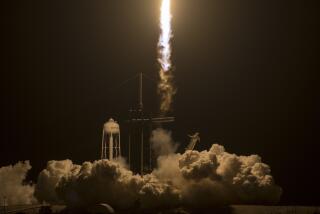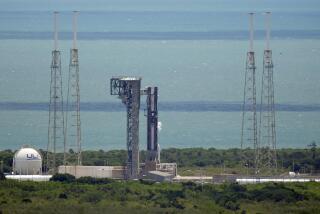Mir Suffers a New Setback; American May Aid in Repairs
- Share via
MOSCOW — In its seemingly endless spate of slip-ups and breakdowns, the crippled Mir space station ran out of power and began drifting Thursday when one of the exhausted crewmen accidentally pulled the plug on the navigation system.
The mishap, which occurred during preparations for a perilous repair mission, plunged Mir into darkness and cut power to oxygen generators, climate control and communications. Mission Control Center officials blamed “human error.”
Only hours later, NASA officials announced that they have given conditional approval for U.S. astronaut Michael Foale to participate later this month in the mission to repair damage caused by a June 25 accident involving a supply craft.
The chaotic breakdowns on Mir are forcing Russia for the first time to accept American help on the mission and NASA to live by foreign engineering standards--major compromises for both parties. At the same time, Congress is questioning the whole cooperative relationship.
And, as Mir staggers into a fourth week of crisis conditions, concerns are mounting that stress and fatigue are taking their toll on the trio compelled to soldier on with the troubled mission in order to show U.S.-Russian solidarity in space.
The error Thursday caused a computer to automatically shut down navigation, sending the craft into a free drift that deprived its solar panels of sunlight needed to produce electricity.
Russian Mission Control chief Vladimir Solovev described the latest power loss as “a very bad situation and serious trouble.” But by late Thursday, the spacecraft had been reoriented and the crew was attempting to recharge its batteries. Power was restored early today; NASA said the astronauts had at least five days of oxygen in reserve.
The National Aeronautics and Space Administration announced in Houston that it had given the go-ahead for Foale to begin preparing for the operation to repair Mir’s electrical system. But final approval will be withheld until after a joint readiness review, said Frank Culbertson, NASA’s head of the Mir missions.
The decision to assign Foale to help with the risky repairs inside Mir marked the most trying test to date of American and Russian cooperation in space.
Rep. F. James Sensenbrenner Jr. (R-Wis.), chairman of the House Science Committee, said in an interview Thursday that NASA is now putting Foale’s life at risk.
“Sure, we have to take the hard times with the good times, but there comes a point where it is imprudent to continue having an American in space on that piece of equipment,” Sensenbrenner said.
But outside experts applauded NASA’s decision, saying it is exactly what the cooperative relationship between the Americans and Russians was supposed to be about.
“If we had said it was too risky for our boy, it would have sent a very strong message,” said John Logsdon, a space expert at George Washington University. “What was Foale going to say? ‘No, I am not going to help’ and then go sit in a corner?”
John Pike, a space expert at the Federation of American Scientists and a frequent NASA critic, said he was bothered by the earlier plan that had Foale safely seated in the Soyuz escape capsule “while the two Russian men went into harm’s way.”
The new plan marks the first time that Russia will concede some real responsibility to an American and the deepest dependence yet by NASA on Russia’s way of doing business in space, he added.
Culbertson defended the United States’ continued participation on Mir, saying it is providing valuable lessons for the planned International Space Station.
None of the officials who briefed reporters in the U.S. or Russia would specify which of the three men on board--Foale, Mir commander Vasily Tsibliyev or flight engineer Alexander Lazutkin--was responsible for the disastrous disconnection, or even which two were training for the repair job when it happened.
“Two men in bulky spacesuits were working in a small, spherical chamber about 2 meters [6 1/2 feet] wide,” Russian Space Agency spokesman Valery Lyndin said, describing the work area as a transit passage the crew will have to depressurize if and when they undertake the repair mission. “One of them touched the cable contact with a hand or a foot, causing contact to be lost between the on-board computer and the sensors.”
Culbertson, however, said the accident was caused when crew members were checking to see how much force would be required to reconnect cables in the damaged Spektr research module and accidentally disconnected the wrong cable.
Interruption of the computerized guidance information caused the power storage system to shut off, and the crewmen were unable to correct the problem before exhausting all battery power and having to turn off life-support systems.
Ground controllers were able to realign Mir’s solar panels to replenish the batteries by firing thrusters on the Soyuz capsule also docked at the space station, Solovev said.
Lights and air generators could not be restarted until the batteries were fully recharged. Until that happened early today, ground controllers had to occasionally fire up the Soyuz engines to nudge the 120-ton space station into proper alignment to avoid its falling from orbit and plunging back to Earth. The Soyuz capsule, which serves as a lifeboat if the Mir occupants ever need to abandon ship, has energy and communications systems independent of the Mir station.
Aside from the technical problems, Mir may be suffering from a crisis of confidence on board, one aerospace analyst here said.
“This crew has been very unlucky,” the analyst said. “Naturally, they are under tremendous stress.”
Tsibliyev has been deemed unfit to perform the risky spacewalk and repair mission because of heart palpitations, and all three men have been reported to be suffering from fatigue.
“We must admit that the cosmonauts, and especially Tsibliyev, have come through a lot of emotional stress caused by the failed docking practice,” said flight control medical chief Igor Goncharov. “Tsibliyev took it very personally and too much to heart, both literally and figuratively.”
Goncharov was referring to last month’s accident, in which a cargo drone being manually piloted by Tsibliyev toward a Mir docking port went astray and crashed into the Spektr module, puncturing and depressurizing it and cutting off 40% of the space station’s power supply.
Tsibliyev has complained of heart arrhythmia since Monday, which prompted the Russian agency to appeal to NASA to let Foale take the Mir commander’s place in the repair mission now tentatively set for next Thursday.
The navigational failure Thursday was at least the third incident cutting power to the space station in as many weeks, and while crewmen can survive for days inside Mir without energy, the life-support systems are vital during work in the vacuum of open space.
Describing Foale’s attitude, Culbertson said, “Enthusiasm would be a good description of how he feels.”
Williams reported from Moscow, Vartabedian from Washington.
More to Read
Sign up for Essential California
The most important California stories and recommendations in your inbox every morning.
You may occasionally receive promotional content from the Los Angeles Times.












